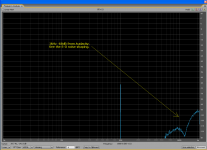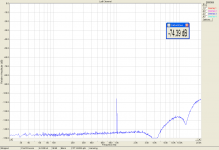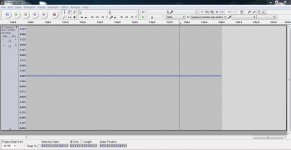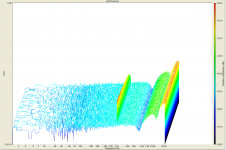Mooly, the sigma-delta modulator you use is funny 😀. Is it DAC or software that makes all that noise shaping???
I assume its the ADC doing it. I've nothing more sophisticated that a Dell Vostro 3750 and Acer 9301 (an old Acer but it keeps on chugging) laptop for producing files and more importantly A-D conversion.
To check low levels, try this
https://www.dropbox.com/s/fqkv5d85ifqxncb/sigtest80.wav
-80dBFS 24bit sine. It MUST sound very clean if you have a 24 bit card. In case it does not sound clean, something is going wrong. If you play it at 16 bits at full volume, it would not sound clean. I speak about analog volume, make no digital amplification.
I will try this at some point... not enough hours in the day 😀 Going to try your exactcopy do-dah next.
You are of course right, but there is an 'information' and useful information. Noise may emphasize a sort of real information, but hides details that are buried more than some 20dB below noise level.
Noise may actually bring signals, which otherwise would be below the threshold of perception and therefore go unnoticed, up to levels above the threshold of perception.
Exercise Caution If You Try This. Read Instructions.
So far yourself and heb1001 have both said you hear nothing. What is surprising is that you have admitted to using full volume.
Remember yesterday I mentioned a test with a watch (or the time counter on your CD player)... well this is that test.
Caution. The next part of this test requires you to listen at full volume via speakers or headphones You must turn the volume up after the track begins and turn it down at the end. It is up to you to know how your system behaves at full volume. I would advise playing the tracks at normal level first and when you are sure you hear no pops or clicks etc then turn the volume up.
🙂 OK
How far (measured in seconds) into each track do you have to go before you hear any test tones ?
I have run test this myself and know that the tones are easily audible. I am listening via speakers and sat around 9ft from them. In other words my normal listening position.
So the question for now is how far into the tracks before you hear the tones ?
It puzzles me what you all actually hear on these tests and so although this is very unscientific it does provide clues as to the resolving power of your systems.
Both these files were produced with Audacity and are in post #511. This link takes you there.
Files
And when you have finished turn the volume down
Both complete silence.
Analogue gain to max, ears against speaker.
I only hear a tiny bit of noise, but it doesn't matter if a file is played or not. That is just the noise from my system.
So far yourself and heb1001 have both said you hear nothing. What is surprising is that you have admitted to using full volume.
Remember yesterday I mentioned a test with a watch (or the time counter on your CD player)... well this is that test.
Caution. The next part of this test requires you to listen at full volume via speakers or headphones You must turn the volume up after the track begins and turn it down at the end. It is up to you to know how your system behaves at full volume. I would advise playing the tracks at normal level first and when you are sure you hear no pops or clicks etc then turn the volume up.
🙂 OK
How far (measured in seconds) into each track do you have to go before you hear any test tones ?
I have run test this myself and know that the tones are easily audible. I am listening via speakers and sat around 9ft from them. In other words my normal listening position.
So the question for now is how far into the tracks before you hear the tones ?
It puzzles me what you all actually hear on these tests and so although this is very unscientific it does provide clues as to the resolving power of your systems.
Both these files were produced with Audacity and are in post #511. This link takes you there.
Files
And when you have finished turn the volume down
I will try this at some point... not enough hours in the day 😀 Going to try your exactcopy do-dah next.
Many thanks 🙂 Worked first time.
Mooly, the sigma-delta modulator you use is funny 😀. Is it DAC or software that makes all that noise shaping???
I assume its the ADC doing it. I've nothing more sophisticated that a Dell Vostro 3750 and Acer 9301 (an old Acer but it keeps on chugging) laptop for producing files and more importantly A-D conversion.
Both these files were produced with Audacity and are in post #511. This link takes you there.
Files
And when you have finished turn the volume down
Mooly, it is the Audacity multi-bit generator that makes the S-D noise shaping (math algoritm). Just evaluated in the file I have generated myself from Audacity. Same is in your files. Was just curious, now I have the answer. Anyway, noise shaping is inaudible, of course, if we use one level. But, it may say something about experiment that Frank (fas42) did yesterday ....... interesting.
P.S.: the plot is moved 12dB up, so the level of the peak is -80dB
Attachments
Last edited:
Anyway, noise shaping is inaudible, .....
I must make a correction of my statement. The audacity noise shaping is very audible, I have just compared it with cleanly generated files. The noise above 10kHz is audible. For those who need to try low level signals, please try
https://www.dropbox.com/s/fqkv5d85ifqxncb/sigtest80.wav
https://www.dropbox.com/s/rbsetjaw0s0ur7s/sigtest.wav
https://www.dropbox.com/s/7v6el9m5r1i0ejy/sigtest110.wav
They are -80dBFS, -100dBFS and -110dBFS 24-bit files, clean, without noise shaping. No excess HF noise there.
The main problem with the Audacity test file that Mooly have provided is a very high level of noise integrated over 20kHz. It is -74dBFS and the audible signal (there is an audible signal) is buried in noise. The right question asked is WHEN (after what time) it becomes audible.
Total power (-74dBFS) is a rms noise here. For those not familiar with FFT it might be confusing, but the spike you see is in fact buried in noise.
Total power (-74dBFS) is a rms noise here. For those not familiar with FFT it might be confusing, but the spike you see is in fact buried in noise.
Attachments
Last edited:
Yuk! Can you recommend a software signal generator that works better than Audacity? 😱
I think you can turn off dither in the quality settings.
Yuk! Can you recommend a software signal generator that works better than Audacity? 😱
Of course!! From freeware, please try ARTA
ARTA Home
Then you can generate completely clean 24-bit signals without noise shaping. Audacity is tricky for serious work. Useless, in fact.
Last edited:
Yes, I've had trouble with Audacity in the past when trying to subtract two audio files to listen to the difference. I was left with a low-level hissing sound even though the files turned out to be identical when I repeated the experiment with Sound Forge. I think I was hearing the same dither signal you found here.
My home setup is based on a Mac so I might struggle to run ARTA, maybe it is finally time to get round to a dual boot installation.
My home setup is based on a Mac so I might struggle to run ARTA, maybe it is finally time to get round to a dual boot installation.
So far yourself and heb1001 have both said you hear nothing. What is surprising is that you have admitted to using full volume.
I can easily hear the -80dBfs 1kHz sine file that PMA posted. 😕
Of cause I did use analyser software, so I know what's in the files. But if you use ABX software to check for audible difference it's not cheating.
I must admit though that I'm not the perfect candidate for listening tests. If I don't immediately hear a difference in an ABX test, the difference is to small to matter to me and I go on to stuff that do make a big difference. Changing the cd for instance.😀
Maybe after training I can hear these small differences, but I'm just not interested.
The Mooly's last test would be fine if there was not that annoying noise shaped HF noise that is quite high in level. Now it depends. Switch of the tweeter or use lowpass and you are there. Worse system may perform better in this last test 

Audacity is doing something wrong when saving as 16bit.
Other bit depths seem well behaved.
Cool Edit has very good functionality. In fact, very Cool functionality.
Threshold1&2 make for competition of 16bit noise compete with playback system noise.
Normalization allows use of volume gain to readily identify signals rising out of floor. FFT filters can be used to further isolate signal.
Questions are how far into what type of noise may a signal be immersed; and how does noise convolve with playback system noise.
In Threshold1 and Threshold2, the rising noise shape >4k does reveal behaviors in my ears. They are 50years old, and tinitus is present. As 4kHz signal rises out of floor, I get HF modulations around signal that stabilize to pure tone of 4kHz as signal rises. 1kHz signal rises with barely perceptible LF modulations before stabilizing to pure tone.
Hair cells for 4kHz on basilar membrane are closer to round window, and grouped closely with the >4kHz response hair cells; 1kHz is located further along basilar membrane.
Also 4kHz is close to typical resonance of ear canal, and traveling waves in ear canal are set up that cause beating, especially with headphones/ear buds.
Other bit depths seem well behaved.
Cool Edit has very good functionality. In fact, very Cool functionality.
Threshold1&2 make for competition of 16bit noise compete with playback system noise.
Normalization allows use of volume gain to readily identify signals rising out of floor. FFT filters can be used to further isolate signal.
Questions are how far into what type of noise may a signal be immersed; and how does noise convolve with playback system noise.
In Threshold1 and Threshold2, the rising noise shape >4k does reveal behaviors in my ears. They are 50years old, and tinitus is present. As 4kHz signal rises out of floor, I get HF modulations around signal that stabilize to pure tone of 4kHz as signal rises. 1kHz signal rises with barely perceptible LF modulations before stabilizing to pure tone.
Hair cells for 4kHz on basilar membrane are closer to round window, and grouped closely with the >4kHz response hair cells; 1kHz is located further along basilar membrane.
Also 4kHz is close to typical resonance of ear canal, and traveling waves in ear canal are set up that cause beating, especially with headphones/ear buds.
What is the frequency distance of individual haircells? Can it be quantified? Is it same over whole band? I am really interested in this, no kidding.
Worse system may perform better in this last test
So mine is seriously seriously E+6 bad then
 😀
😀 On speakers listening approx. 9 ft away I can reliably pick the tones out of the noise at around 17 to 20 seconds in. That is playing the files direct off USB in the Marantz. The white noise I hear isn't from the amp because it drops off to next to nothing when I pause the player. The tones stand out quite cleanly though.
Pretty similar picture with the Sony headphones plugged into the Dell too.
The picture showed how the signal looked in 😱 Audacity.
Attachments
Last edited:
What is the frequency distance of individual haircells? Can it be quantified? Is it same over whole band? I am really interested in this, no kidding.
I believe around around 1.3mm per Bark There are 24 bands with one third octave spacing. Band 24, the highest, has a centre frequency of around 13.5kHz and around 3.5kHz bandwidth.
(I'm no expert, just have an interest too)
Yes we know it was the amplitude sweep 🙂
😛 I am in awe at your skills handling the files 😀
Its all new to me... I was just thrilled to find Audacity had a record level control after you all complained of clipping in the opamp test on the Bach... but I'm learning slowly.
- Status
- Not open for further replies.
- Home
- General Interest
- Everything Else
- Based on sonics... which do you prefer ?



